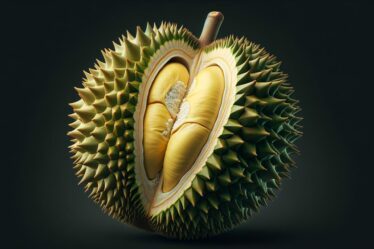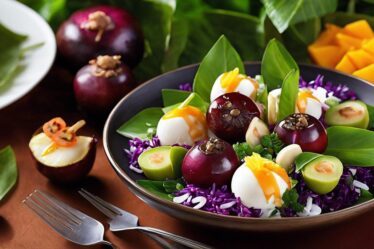
In the vast and varied realm of fruit, one stone fruit that seamlessly blends versatility, flavor, and nutritious value is the nectarine. A close cousin to the iconic peach, the nectarine is indeed a dynamic stone fruit that’s brimming with possibilities, from culinary versatility to robust health benefits. This examination delves into understanding the unique nuances that set the humble yet intriguing nectarine apart, offering an enlightening exploration into its flavorful profiles, beneficial components, and practical guide on selection, storage, and culinary utilization.
The Nectarine VS The Peach
“Nectarine vs. Peach: The Tale of Two Summertime Darlings”
Picture this: a sizzling summer afternoon, the sun pouring its brilliant hues, a backyard barbecue, and a bowl of glistening, jewel-like fruits. Amidst the inviting assortment, two familiar favorites often strike intrigue – the nectarine and the peach. They may seem like interchangeable twins at first glance, but both pack distinct identities that can kindle any culinary lover’s fascination.
While both fruits make for glorious summer additions, nectarines and peaches boast distinctive differences with subtle similarities. Why does it matter, one may ask? Well, when it comes to culinary craftsmanship and savouring the essence of every bite, understanding the subtle nuances between ingredients is paramount.
Starting with the visual cues, one significant difference that stands out is the skin. Peaches sport a fuzzy, velvety coat, while nectarines astound with their smooth, bald exterior. This peach fuzz, also known as trichomes, isn’t just for aesthetics. It provides a natural defense against bugs, molds, and UV light damage. Nectarines, in contrast, owe their smooth look to a recessive gene – a lack of fuzz doesn’t make them any lesser beings, and their shiny, bald brilliance is aesthetically appeasing to many.
Underneath that skin lies the flesh, offering another point of distinction. Both nectarines and peaches come in varieties where the flesh clings to the stone (clingstone) or separates from it (freestone). However, the nectarine’s flesh tends to be a tad more dense and firmer, offering a slightly different mouthfeel.
As you bite into a ripe nectarine or peach, it’s hard not to revel in the delightful burst of sweetness. Both fruits, part of the Rosaceae family, share a similar sweetness profile thanks to their high sugar content. But nectarines typically feature a bit more assertive flavor profilecast, with a sharper, spicy zing that contrasts the overt sweetness. Peaches, on the other hand, display a subtler, milder flavor with a more gentle sweet-to-tart ratio.
The seasonality and versatility of both fruits equally amaze. Electronic markets brim with these juicy gems during the summer months, and they both perform spectacularly whether showcased in a rustic tart, paired with a creamy burrata salad, or simply enjoyed fresh off the tree.
In terms of nutritional composition, both peaches and nectarines are champions of good health, albeit with slight differences. Both fruits are packed with beneficial fiber, antioxidants, and vitamin C. However, measure for measure, nectarines pull slightly ahead with higher quantities of potassium and twice the vitamin A than peaches.
In essence, the nectarine and peach are more like close siblings than distant cousins, each bearing unique qualities while sharing a common heritage. Whether it’s the peach with its fuzzy charm and delicate flavor or the nectarine with its vibrant, assertive zing and smooth complexion, they’re both culinary superstars in their own right. As with any ingredient, it all boils down to personal preference. So, next time you’re roaming the sun-kissed fruit aisle, spare a thought for these lovely stone fruits. Embrace their beautiful differences and treat your taste buds to a seasonal, fruity delight.
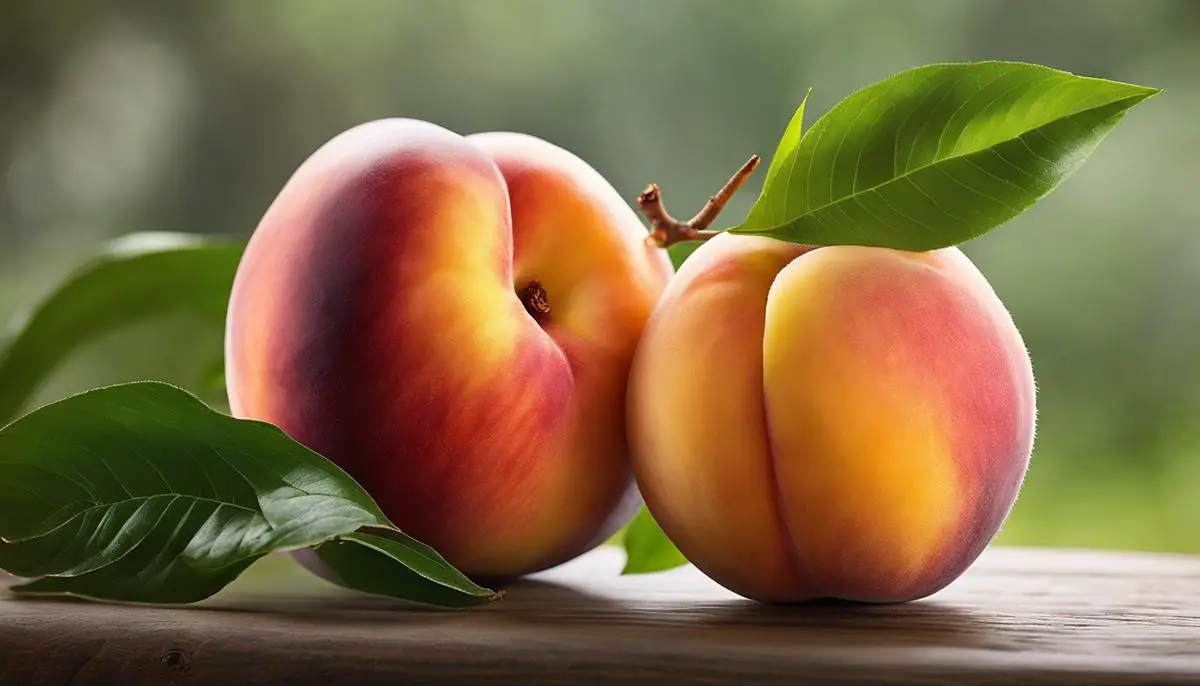
The Nutritional Value of Nectarines
Titled: “Nectarines: A Delicious Guide to Elevating Your Well-being”
In the world of culinary diversity, rejoicing in the delight of nectarines is an exquisite and delightful experience. Renowned for its smooth skin, denser flesh, and mesmerizing flavor, the nectarine is beyond comparison for any fruit aficionado keen on exploring new taste dimensions.
What’s remarkable is that the excitement doesn’t halt at taste and texture alone. The nectarine, a relative of the peach, packs a punch when it comes to health benefits. In fact, diving into a nectarine is like embarking on a journey toward nutritional excellence, all while spoiling your taste buds with an enchanting burst of sweetness and acidity.
The charm of nectarines extends far on the journey to good health. Each bite contributes to the well-being crusade by offering a significant dose of essential minerals and vitamins. Just one medium nectarine provides about 9% of the daily recommended intake of potassium, a mineral integral to heart health, nerve function, and muscle contraction.
Furthermore, nectarines are a powerful provider of antioxidants that scavenge harmful free radicals in the body. This antioxidant potential, attributed to their deep orange color, makes them a top choice for maintaining youthful skin and boosting the body’s defense mechanisms. Plus, nectarine’s lutein and zeaxanthin content aids eye health, making them a tasty prescription for preserving sight.
The road to immunity is paved with nectarines as well! As sources of vitamin C, they enhance the body’s ability to repair tissues, absorb iron, and fight off infections, all while keeping teeth and gums healthy. It’s an invigorating citrusy chase for a robust immune system but garnished with an irresistible fruity appeal!
Dietary fiber is yet another gem in nectarine’s repertoire. With a handsome piece of nectarine giving approximately 8% of the daily recommended fiber intake, it’s a winning strategy for promoting digestive health, regulating blood sugar levels, and managing weight.
Don’t overlook the vitamin A quotient, either. A byword for good vision, healthy skin, and a well-functioning immune system, Vitamin A is generously served up in nectarines, enhancing their rightful place in a balanced diet.
In the culinary world, where taste rules and health is a cherished companion, nectarines emerge as a stone fruit par excellence. Their mouth-watering delight, coupled with nutritional merit, can elevate any meal to a gastronomic and healthful feast.
However, a seasoned foodie knows that balance is key. Whether you’re whipping up a nectarine salad, crafting a nectarine salsa, or baking a nectarine tart, a gentle approach emphasizes their bold flavor while preserving their nutritional integrity. After all, it’s about marrying flavor and health in a single, tantalizing bite.
Delving into the pleasures of nectarines isn’t merely an adventure in flavor and texture. It’s about harnessing their dietary benefits to contribute to a healthy lifestyle, all while indulging in their exquisite taste. Truly, what could be more savory and gratifying than a bite of health wrapped in deliciousness? This is the nectarine life and it’s absolutely divine!
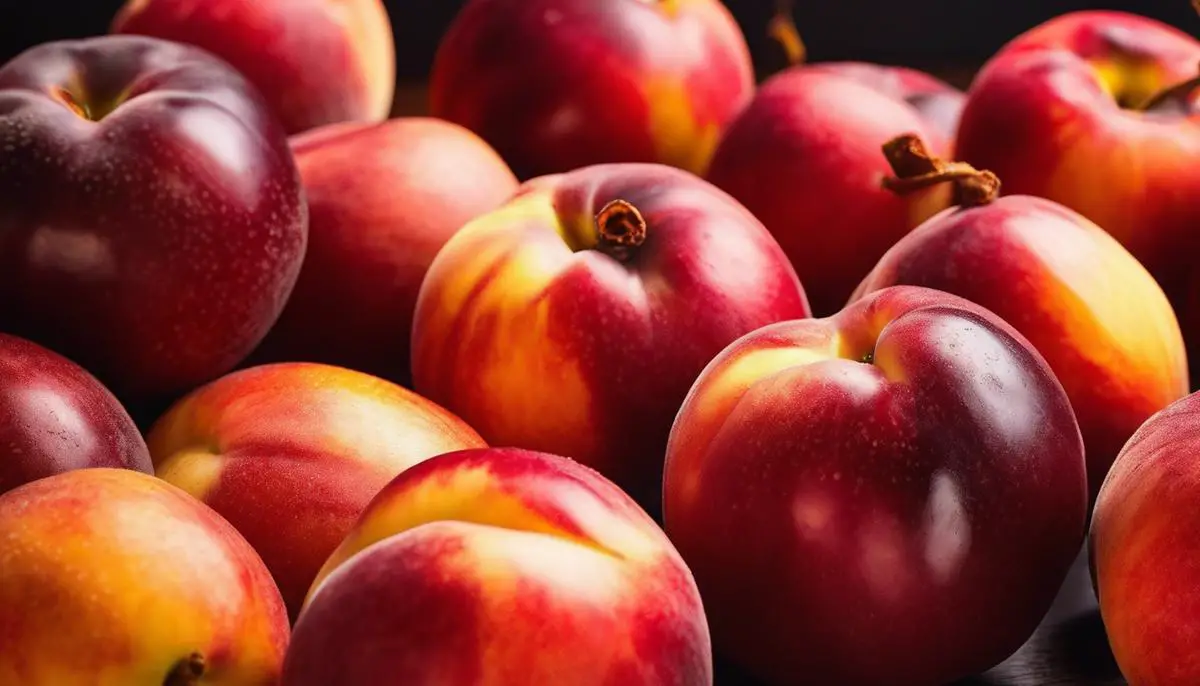
Selecting and Storing Nectarines
Sailing into the bursting panorama of vibrant fruit stands, every true flavor explorer carries one knowledge always on their forefront – the art of selection. Picking an ambrosial nectarine is not some casual endeavor; it is an intricate dance waged between eyes, hands, and the soul’s craving for sweetness. So, how exactly does a food lover navigate through this game of perfect nectarine selection?
Imagine walking into your local fruit market; you’re hit instantly by an aromatic mafia of fruits. Setting your gaze upon the nectarine stand, you see an array of nectarines ranging from fiery rouge to a tantalizing golden hue. But don’t be taken in by those scarlet superficies; excellent nectarines may shy away in more mellow tones. The secret lies in the background color that should sway more towards rich, deep yellow shades and less the green. These golden-hued gems are the products of extended sun bath, a guarantee of their luscious maturity.
Feeling for firmness comes next as that is an act truer to a nectarine’s inner essence. Gently press its skin; too soft may signify overripe tendencies, yet too hard ups the chance it was plucked prematurely, hence lacking in flavorsome juice. Seek that sweet middle ground, a slight give signifying the nectarine’s readiness for the arenas of your taste buds.
The olfactory scene is a crucial play in the game. Aroma should not be skimped on; a mouthwatering nectarine reveals some of its dazzling sweetness even before the first bite. Sniff it faintly – a desirable nectarine is proud of its scent, a stark promise of its inherent sugariness concealed beneath the smooth skin.
Finally, it’s advisable to use them slightly chilled or at room temperature for that optimal, juicy bite. Remember that refrigeration can tamper with the nectarine’s real flavors, so it’s always best to let it sit at room temperature a while before relishing.
So, it’s not just about having them on your kitchen counters or in your refreshing summer salads. The humble nectarine plays a tricky yet gratifying game of visual allure, firm promise, fragrant mysteries, and careful preservation to ensure that each bite you take is a celebration of flavors galore. Here’s to the delightful journey of selection and savouring this blushing, sweet-tart wonder of the natural world. Enjoy the bounty!

Cooking and Baking with Nectarines
Bold and punchy, with a distinctive sweet-tart flavor, nectarines are a beloved summertime treat.
But their appeal extends far beyond their convenient snack-ability. With a little culinary creativity, the adaptable nectarine can transform a variety of dishes, taking your cooking and baking adventures to new and delightfully delicious heights.
For instance, enhance breakfast dishes with the vibrant flavor of nectarines. The unmistakeable zing of fresh nectarines can elevate a bowl of creamy Greek yogurt, charge up chia seeds in a pudding, or lend a refreshing twist to your avocado toast. Another unique culinary endeavor is folding nectarine slices into pancake or waffle batter; the heat will caramelize the fruit’s sugars, adding a fascinating depth of flavor to your breakfast feast.
Nectarines also make a formidable addition to salads. Whether it’s a classic poultry or shrimp salad, or a quintessential caprese — fresh basil, buffalo mozzarella and tomatoes — replacing or supplementing tomatoes with ripe nectarines can instantly make a tried-and-true recipe taste like a brand new culinary invention.
Additionally, grilled nectarines can be as much of a summer barbecue staple as hamburgers and corn on the cob. Cut in halves or slices, nectarines can be tenaciously grilled, their high sugar content leading to magnificent caramelization. Tossed on a grill, the smoky heat amplifies their inherent juiciness and tartness, making them an unexpected, yet splendid accompaniment to grilled skewers or as an additional layer in a veggie burger.
In the realm of baking, nectarines wield impressive versatility. Consider nectarine tarts, for example, where the firm texture of the fruit holds well against a buttery, delicate crust. Furthermore, cakes imbued with nectarine chunks or thin layers of nectarine slices not only lend a refreshing textural contrast but also spice up traditional dessert profiles with their vibrant tang. Nectarine-based jams, jellies, or compotes also top off pastries brilliantly, be it a rustic toast, a sophisticated croissant, or even a timeless bagel and cream cheese.
For something more robust, salsas and chutneys carrying the full-bodied flavor of nectarines can add a gourmet touch to an array of main dishes, from hearty roasts to flaky fish filets. The vivacious, assertive notes of nectarine can electrify these dishes, creating complex taste profiles that will undoubtedly leave a long-lasting impression on your palate.
There you have it, a whirlwind of inspired cooking and baking ideas designed to get every food lover excited. The nectarine, in all its vibrant, tart glory, is an essential addition to the culinary canvas, ready to bring a burst of flavor and lively character to your kitchen adventures. So, go ahead- throw caution to the wind, get creative, and let the exhilarating world of nectarine-infused culinary artistry burst into life on your plate!
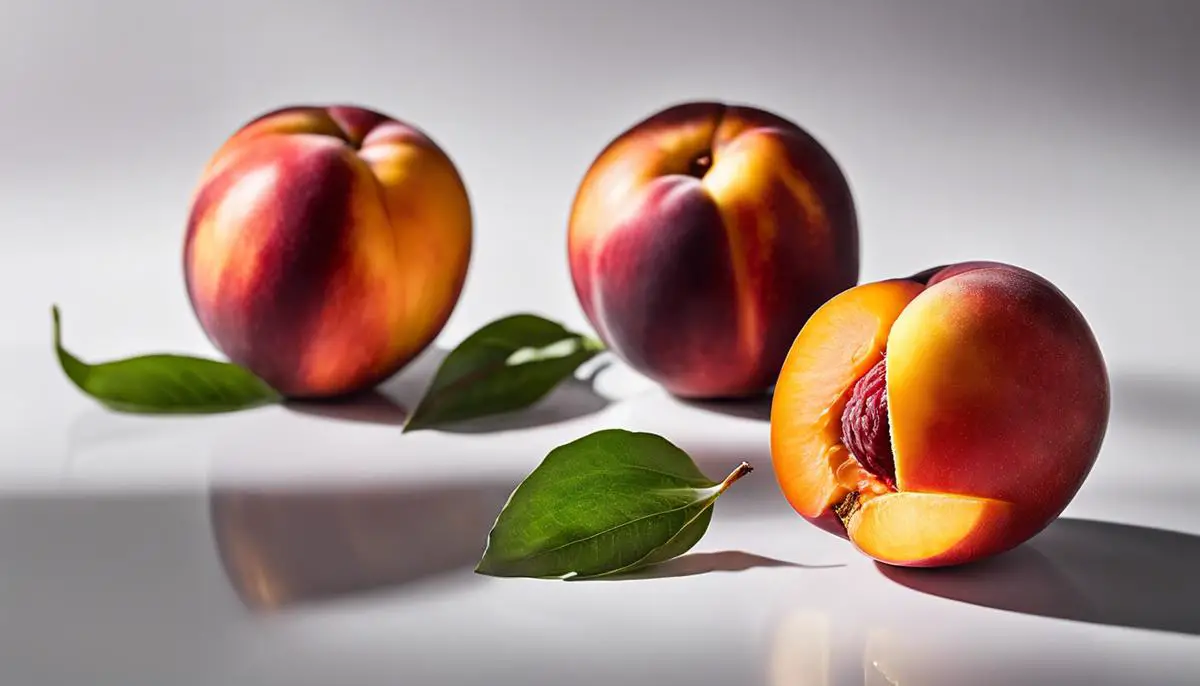
Pairing Nectarines with Other Ingredients
Diving into the world of food pairings with nectarines, the peach’s smooth-skinned cousin, opens up a treasure chest of gastronome delights. From breakfast to dinner, savory to sweet, nectarines can effortlessly elevate meals, creating a symphony of flavors certain to tantalize the palate.
To begin, let’s talk breakfast. A ripe, juicy nectarine can transform oatmeal into a fiber-rich, vitamin-packed morning kickoff. Slice them up, warm slightly and sprinkle with a touch of cinnamon; the assertive zing of the nectarine pairs beautifully with the warm spice. Likewise, they hold their own in Greek yogurt parfaits, blending the creamy tanginess of the yogurt with their sweet tartness, while also enhancing the earthy, nutty crunch of granola.
It shouldn’t be forgotten that nectarines share a wonderful affinity with salads. Their vibrant, sweet tartness harmonizes wonderfully with the saltiness of feta cheese or the tenderness of grilled chicken. The bright orange flesh contrasts against greens, adding a pop of color and interest, while their sharp taste offsets the creaminess of any dressing.
When it comes to grilling, nectarines are game changers. Their firm flesh softens with heat, releasing a divine sweetness that complements the smoky essence of grilled meats. Try with pork or fish – the natural sweetness of honey-glazed pork or spicy marinated white fish like halibut, gets lifted by the fruity undertone of nectarines.
In the realm of baking, nectarines prove to be versatile and exceptionaly flavorful. Substitute peaches with nectarines in a classic fruit tart or pie. The firm flesh holds shape while the inside becomes gooey and delicious, standing up to the buttery crust. When combined with almond in crumbles or tarts, the nutty almond and juicy nectarine create a match made in heaven.
For jam or compote, nectarines lend their distinctive flavor beautifully, making a versatile topping with a delightful balance between sweetness and tartness. Pair a homemade nectarine jam with a creamy brie, spread it on a crostini, and it is a party appeitizer hardly anyone can resist.
Salsas and chutneys become a delightful treat when nectarines step into the scene. Their vibrant taste brings a fresh and sweet character to spicy salsas. Mix in red onions, cilantro and a squeeze of lime for a summer barbecue accompaniment that’s a definite crowd pleaser. Similarly, they lend a delectable sweetness to chutney, making a suitable complement for curry dishes or grilled meats.
A definite crush for every foodie, nectarines are more than just a typical summer fruit. With this zesty and juicy delight at hand, the possibilities are endless, unifying diverse flavors and inviting everyone to a heavenly culinary journey. Be bold, take the leap and explore the versatility and distinctive zesty twist of nectarines.
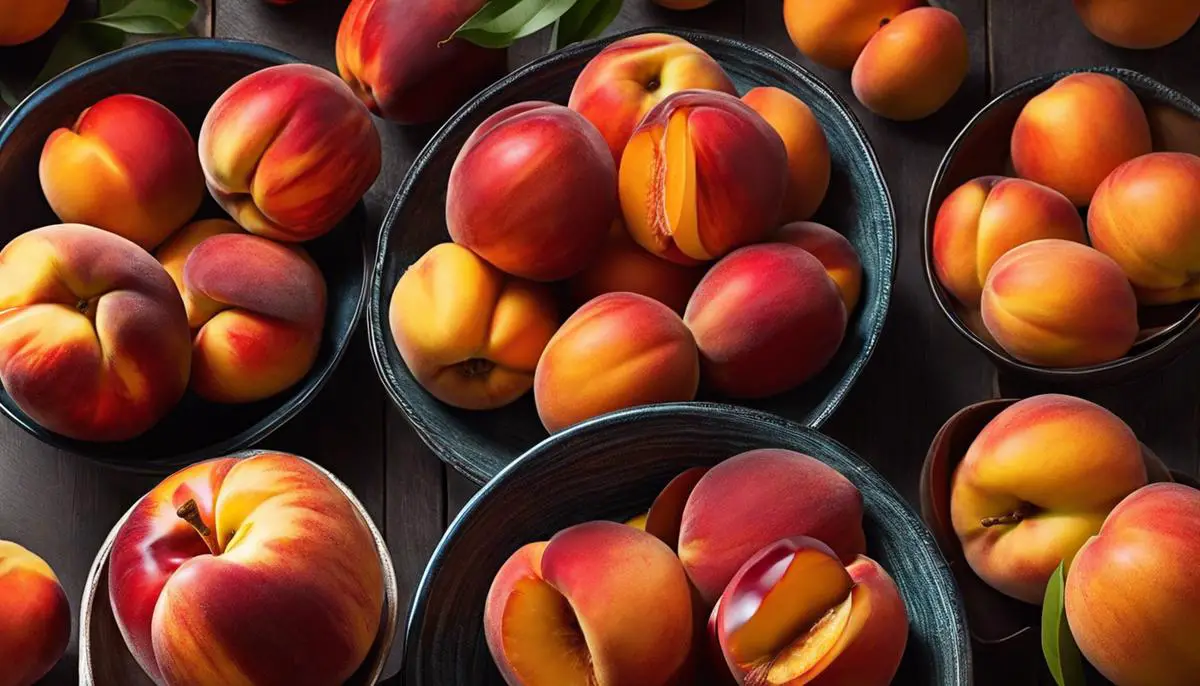
There is an undeniable richness associated with the nectarine, one that’s not only reflected in tantalizing taste profiles but is also concealed within its nutrient-rich heart. This versatile stone fruit, whether integrated into inventive culinary concoctions, savored with diverse ingredient pairings, or utilized for its numerous health benefits, presents an inexhaustible array of advantages. Replete with possibilities, the nectarine stands as a testament to nature’s bounty, a fruit medium that fuses flavors, nutritional merits, and our culinary curiosity into one delightful package.

